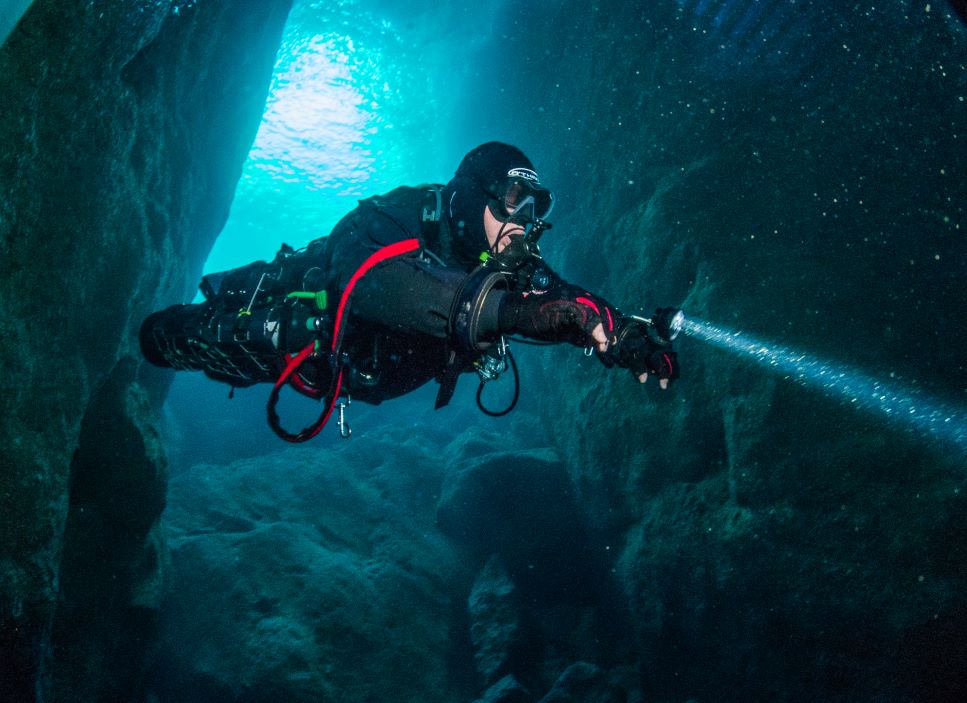I got asked recently about choosing a Sidemount CCR. Of course, this is a subject that will lead to war on social media, but I thought I would put my reasons into the mix.
Manual v E-CCR
Many cave and very experienced (old?) CCR divers favour a manual unit. It makes sense in a lot of ways being able to manually control loop volume and PO2 in an environment with a lot of depth changes. The thing is, if you stop doing this on a manual unit it can go hypoxic, or if a constant flow valve type even hyperoxia. As any CCR diver will tell you both those situations are very, very bad.
E-CCR’s and the associated components and electronics are these days very reliable. It is technology that will keep you alive in the event you are distracted by an incident or task loaded. Good E-CCR’s can also be run as a manual unit to manage failures, but also as a choice, say to control loop volume in changing depths, but with a low safety set point so the unit will automatically maintain a breathable loop if the user does not, say 0.4. So, all the advantages of manual, without the risks specific to manual.
To my mind manuals are yesterday’s technology with no functionality or benefit and considerably more risk over an E-CCR unit. Run the E-CCR manually over a low setpoint and you keep all the benefits of manual with a significant safety net. Manual CCR is really stepping back 10-20 years. If you think todays electronics risk of failure justifies a manual unit you haven’t really looked at the reliability of today’s electronics.
If this argument makes sense to you then units like the Kiss Sidewinder, Sidekick and Golem Flex amongst others need huge advantages in other areas to overcome their manual basis.
Counterlungs
This is a big challenge on Sidemount ccr’s. The units desired position means that it is difficult to get counterlungs that are in the right place relevant to your own lungs to minimise hydrostatic differences between the two and make breathing easy, known as work of breathing or WOB. There are really 3 main solutions that Sidemount ccr designers have used.
Bellows/ Accordion style counterlungs
The benefit of these is that they fit nicely into a cylinder type tube. Because they act as both inhale and exhale lung, you are effectively transferring a breath from your lungs to outside your hip or chest. This causes buoyancy changes. These changes demand a cross tensioning of the unit to stop it moving as it becomes alternatively positive and negatively buoyant. If done well the unit does not move, but this fixation means the diver must compensate for the buoyancy change at the hip with each breath.
It is also a challenge to make bellows lungs flood tolerant. Any unit that is not flood tolerant is a massive risk and puts a big mark for me against units with these lungs, I could maybe cope with the irritation of my hip being lifted and dropped with each breath… I’d rather not! These lung types have another big issue, they will not breathe at all when vertical and as much as we aspire to flat trim all the time, some wrecks and caves are not very accommodating to this need!
External lungs
The most popular unit with these lungs is the Kiss Sidewinder, it really helps work of breathing, probably best in class, but means both the lungs and the breathing hose (over shoulder routing) are very exposed. Demounting the unit to pass a restriction is also challenging.
Inhale/exhale lung
As far as I know only the Liberty, Proteus and T Reb have proper inhale lungs with good water traps. This means they are flood tolerant and have no buoyancy change or hip lift for the diver with each breath. The Liberty lung position is especially good for work of breathing. This design allows water to be purged from the exhale lung making a flood recovery (say someone kicked out your mouthpiece briefly) possible.
In summary a flood tolerant solution with good work of breathing in all positions is paramount. If achieving this means more plumbing routed around the body to offboard lungs and creates an inability to demount the unit, then why even bother using a side mount unit, unless you dive flat, height restricted bedding planes!
Onboard v Offboard Gases
Almost all the Sidemount units on the market today rely on offboard gas connections to O2 and/or diluent gases. Some of them look like a home plumbed bathroom with the amount of connections and hoses routed across and around the body. I have seen divers in ‘Sidemount’ that have o2 and diluent bottles mounted on a backplate defeating many of the advantages that Sidemount was developed for. Commonly O2 bottles are butt mounted along with suit bottles and torches. Now I have a fair amount of real estate on my butt… but all that is too much! Any offboard to lungs or gases makes mounting and demounting the unit a pain.
The only unit I know that has all onboard gas is the Liberty. Now, you want the ability to offboard gas in case of primary supply failures, the Liberty needs some mods to make this work, but they are simple and easy to do.
Size, Position on Body, Streamlined
Open circuit sidemount’s main advantages are that cylinders are trimmed and tight to the body, that they have no protrusions and are unmoving. Equally important is that they are quick and easy to don and doff. This achieves a flexible torso for the diver allowing twisting and bending. Demounting the cylinders in a dive creates a profile allowing gas in front and gas behind for restrictions, as well as leaving a very small profile for the diver.
This open circuit sidemount flexibility is compromised in any Sidemount CCR that is bigger than a 12-litre steel in height and circumference, has offboard gas feeds and blocks or external components like scrubbers or counterlungs.
There are only a very few units that to my mind are streamlined and the right size, two are the T Reb and the Liberty. As the T Reb has offboard gas I am afraid it gets crossed off my list.
So, there you have it, my criteria for a Sidemount CCR
- No offboard Components or plumbing
- Full ECCR Electronics
- Easy to run Manually with a low setpoint
- All gases on board
- Flood Tolerant
- Easy WOB in all positions – so no bellows counterlungs
- Ability to have offboard gases added in an emergency
and the Liberty is the only unit that meets all the requirements.
Others will argue, though justifying the downside of manual units, bellows or offboard lungs, offboard gases etc is going to need an original and well reasoned argument if I would change my mind!
Matt
Matt Jevon, M.Sc. F. IoD is a Full Expedition level Trimix and Cave instructor on OC and CCR with TDI and ANDI. He is the JJ-CCR and Divesoft Liberty Sidemount instructor and dealer for Ireland. Matt’s personal diving has included cave exploration in the Philippines, wreck projects in Croatia and Ireland as well as being one of the inaugural dirty dozen in Truk! Matt has held accreditations as an interdisciplinary sports scientist, sports psychologist with BASES and was a British Olympic Registered Strength and Conditioning Coach and invitee on the Olympic Psychology Advisory Group. Matt works in high performance business as a board advisor and non-exec, high performance sport and is a partner in South West Technical Diving in Ireland. www.swt.ie and writes the Facebook page Psychological Skills for Diving
#tdidivecentre #andifacility #Apekstechnicalcentre #caveinstructor #jjccrfactoryservicecentre #JJCCR #ANDI #nolimitsexploration #cavediving #Apeks #divesoft #sidemountccr #southwestech #nautilus #othree90ninety #divemorepostless #xdeep #TDI #technicaldiving #scaleolights #rebreathers #seacraft #kubidrygloves #sidemountessentialsinstructor #sidemountccr #libertyccr #jjccr_official #wedontsellwhatwedontdive #nobubbles #diving #deepdive #techdiving #technicaldiving #ccrdiver #underwater #trimix #wreckdiver #cavediver




